Lunar Meteorite: Northwest Africa 8455 clan
The NWA 8455 clan consists of paired stones NWA 8455, 8607?, 8609, 8651, 8668, 8727, 8783, 10130, 10228, 10621, 10953, La'gad, & three unnamed stones



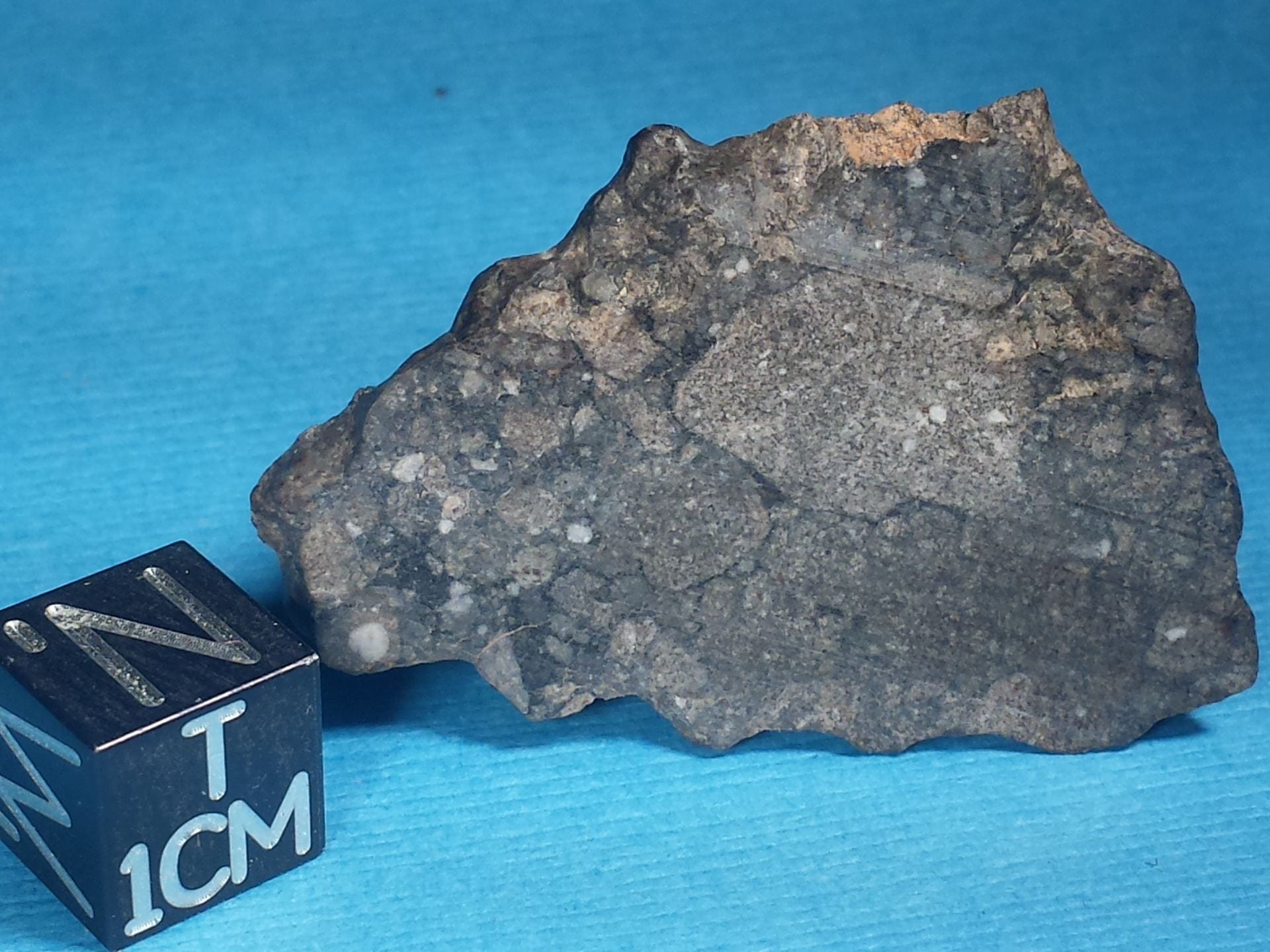

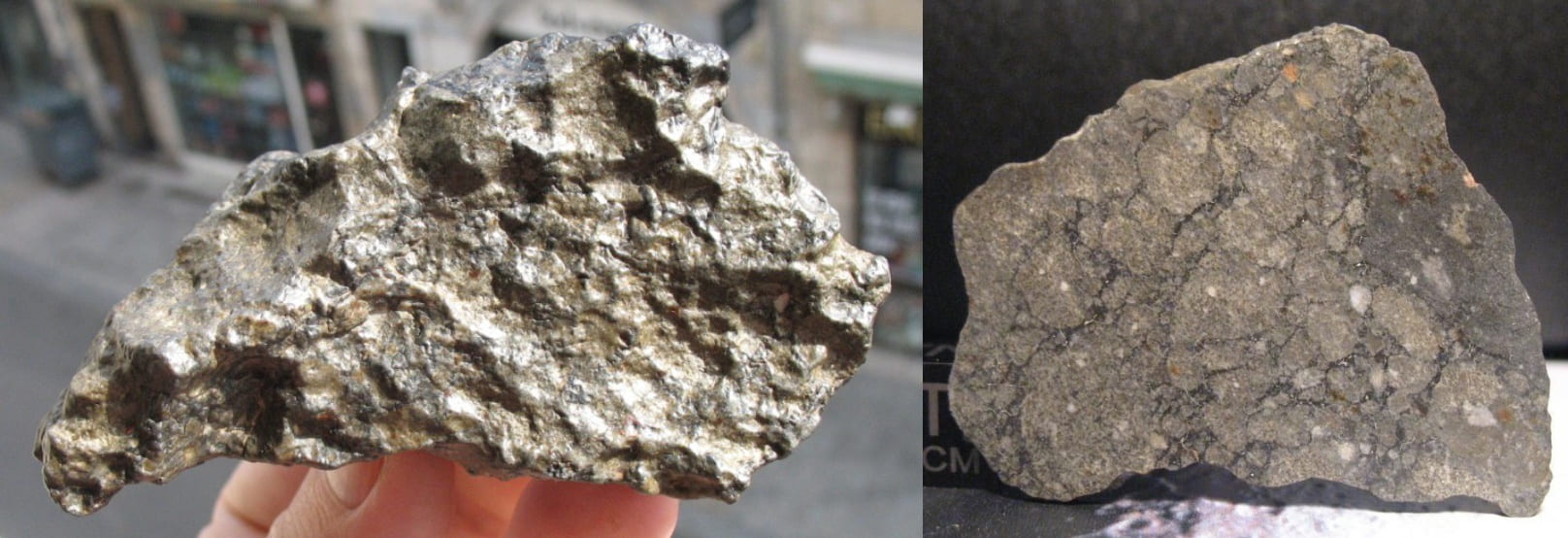




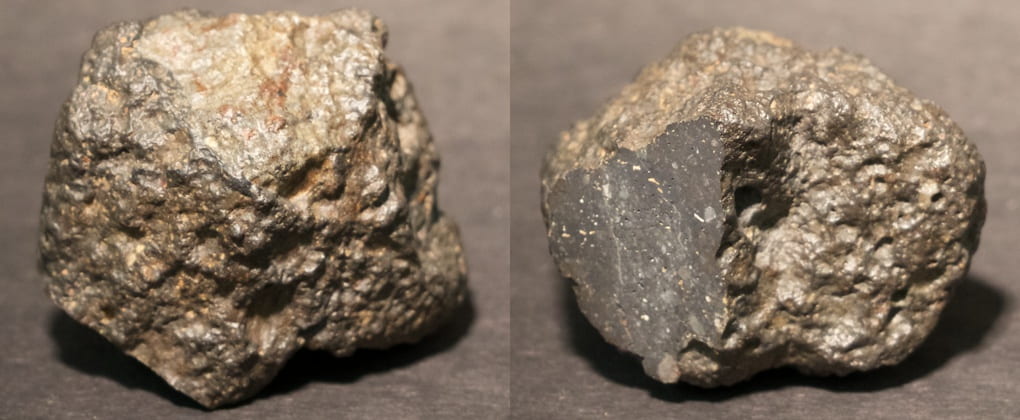


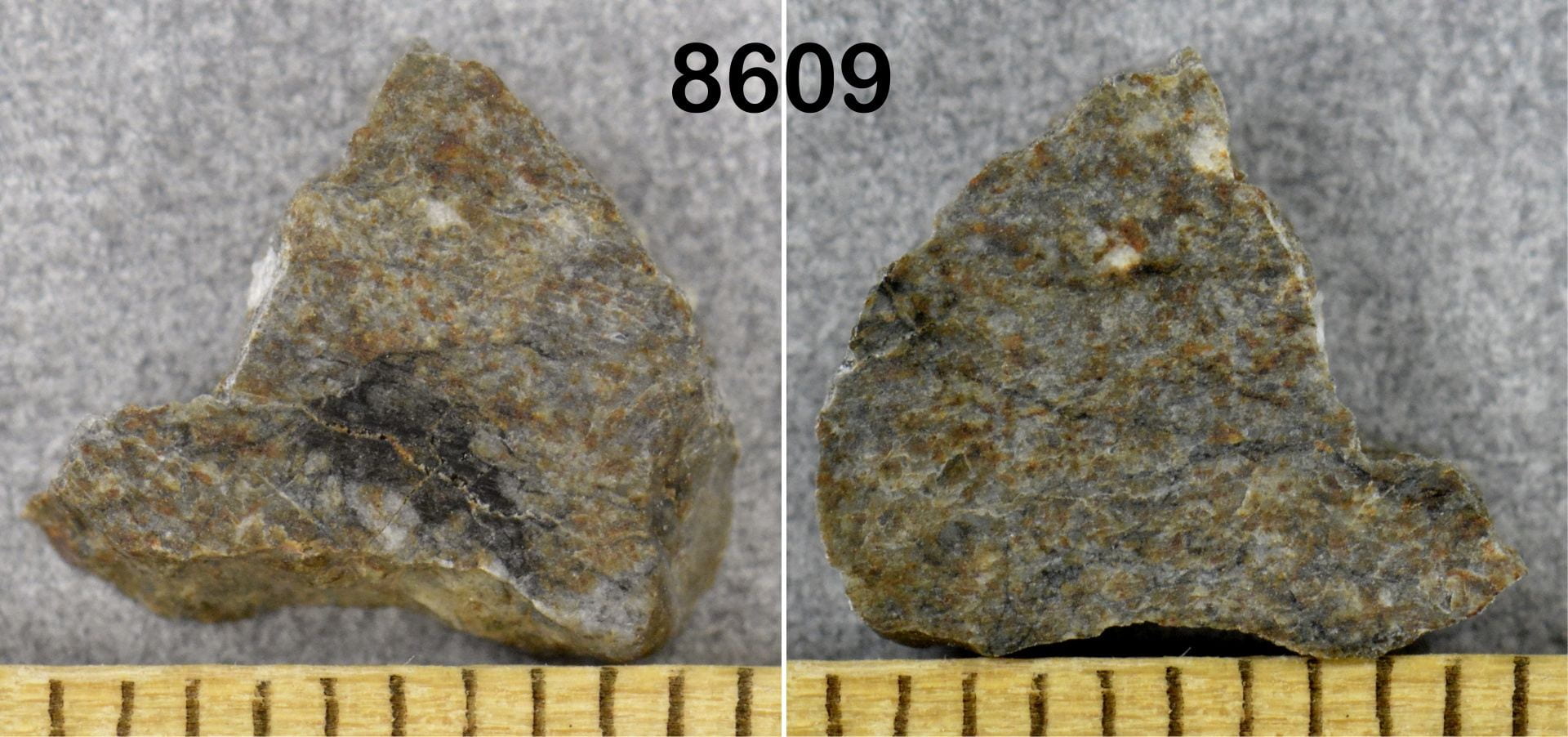




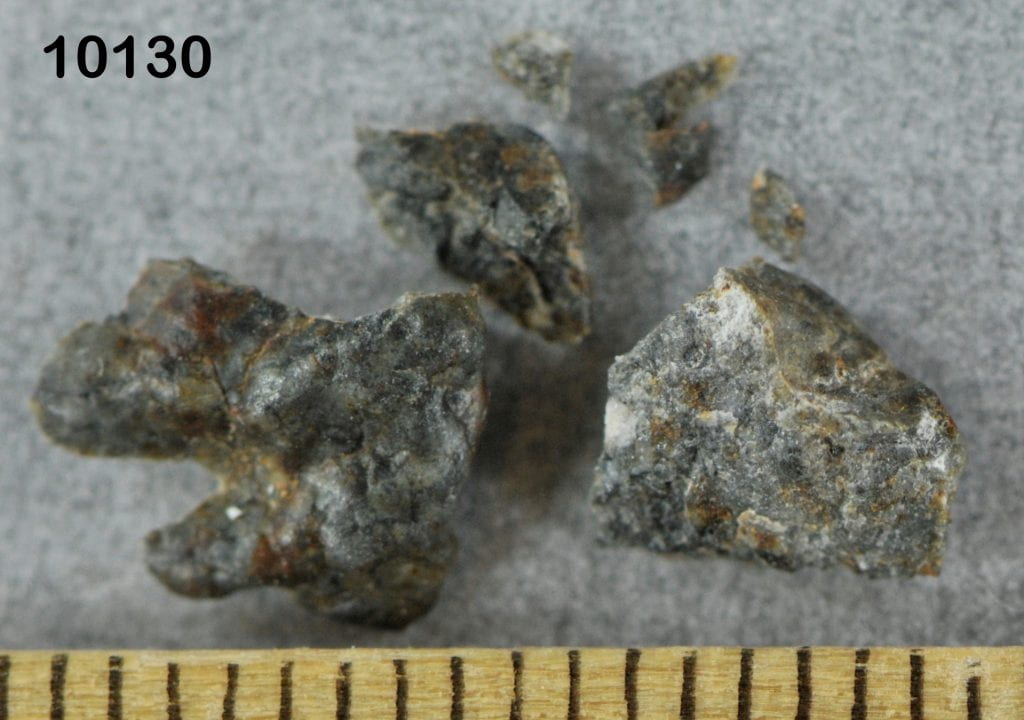

|
from The Meteoritical Bulletin, No. 103 Northwest Africa 8455 (NWA 8455)(Northwest Africa) Classification: Lunar meteorite (feldspathic breccia) History: Purchased from a Moroccan meteorite dealer in 2014. Physical characteristics: Single stone, no fusion crust, irregular exterior with desert patina, freshly broken surface and saw cut reveals a few scattered millimeter-sized white feldspar clasts set in a very dark gray groundmass. Petrography: (C. Agee, UNM) Microprobe examination of a polished mount shows this specimen to be a fragmental breccia composed of clasts (up to ~500 µm) of individual plagioclase, pyroxene, olivine grains, and also lithic clasts (up to ~1 mm) of gabbro and shock melt, set in a pervasive matrix of micrometer- to submicrometer-sized silicates. Accessory ilmenite, silica polymorph, chromite, phosphate, Fe-metal. Geochemistry: (C. Agee and N. Muttik). Olivine Fa26.6±3.5, Fe/Mn=100±9, n=28; pigeonite Fs26.2±6.2Wo8.7±4.4, Fe/Mn=58±5, n=22; augite Fs21.5±8.4Wo34.5±6.8, Fe/Mn=55±11, n=11; plagioclase An95.1±1.0Ab4.5±1.0Or0.4±0.1, n=4. Shock melt (proxy for bulk composition) SiO2=44.6±1.1, TiO2=0.59±0.53, Al2O3=26.1±3.2, Cr2O3=0.10±0.03, MgO=6.8±1.8, FeO=5.0±1.3, MnO=0.04±0.03, NiO=0.02±0.01, Na2O=0.69±0.20, K2O=0.19±0.04 (all wt%). Classification: Achondrite (lunar feldspathic breccia) Specimens: 20.5 g, including a probe mount is on deposit at UNM. J. Piatek holds the main mass. |
|
from The Meteoritical Bulletin, No. 103 Northwest Africa 8607 (NWA 8607)(northwest Africa) Lunar meteorite (polymict breccia) History: Purchased by Adam Aaronson in Morocco, 2014. Physical characteristics: Single stone, no fusion crust, irregular sandblasted exterior. A saw cut and polished surface reveal a breccia with multiple textural lithologies and prominent shock melt veining. Petrography: (C. Agee, UNM) Microprobe examination of polished, saw-cut surface of deposit sample shows a breccia with multiple lithologies: Lithology A (olivine gabbro-norite), Lithology B (olivine gabbroic anorthosite), Lithology C (fragmental feldspathic breccia), Lithology D (shock melt). Fe-Ni metal, sulfide, chromite, ilmenite, and phosphate are ubiquitous accessory phases throughout this meteorite. Geochemistry: (C. Agee and N. Muttik, UNM). Lithology A (olivine gabbro-norite): olivine Fa29.2±1.6, Fe/Mn=98±6, n=13; low-Ca pyroxene Fs25.6±1.5Wo3.8±0.6, Fe/Mn=57±6, n=15; pigeonite Fs25.0±5.1Wo12.3±7.7, Fe/Mn=59±8, n=8; augite Fs9.9±4.4Wo42.6±2.8, Fe/Mn=40±7, n=2; plagioclase An95.7±0.6Ab4.0±0.6Or0.3±0.1, n=8. Lithology B (olivine gabbroic anorthosite): olivine Fa25.9±1.5, Fe/Mn=97±11, n=29; pigeonite Fs19.5±2.0Wo8.4±2.7, Fe/Mn=50±4, n=33; augite Fs13.8±3.1Wo38.1±1.8, Fe/Mn=44±7, n=8; plagioclase An92.6±3.0Ab6.7±2.8Or0.7±0.2, n=12. Shock melt (20 µm defocused electron beam, proxy for bulk meteorite composition): SiO2=44.18±2.80, TiO2=0.58±0.35, Al2O3=24.44±4.70, Cr2O3=0.16±0.09, MgO=6.99±2.41, FeO=6.89±2.97, MnO=0.10±0.05, CaO=13.94±1.98, NiO=0.02±0.03, Na2O=0.54±0.35, K2O=0.15±0.07 (all wt%), Fe/Mn=84±29, Mg#=64.6±6.3, n=24. Classification: Achondrite (lunar polymict breccia) Specimens: A total of 21.4 g including a probe mount on deposit at UNM. Aaronson holds the main mass. |
|
from The Meteoritical Bulletin, No. 103 Northwest Africa 8609 (NWA 8609)(northwestern Africa) Lunar meteorite (feldspathic breccia) History: Purchased by Matt Morgan and Lee Morgan in 2014, reported found in Morocco. Physical characteristics: Single stone, dark brown, irregular weathered surface. Saw cut reveals a range of light and dark mm-size clasts and mineral fragments set in a dark-gray matrix. Petrography: (C. Agee, UNM) Microprobe examination of a polished mount shows a fragmental breccia of plagioclase, olivine, and pyroxene grains, also feldspathic clasts, melt clasts, and microgabbro clasts. Accessory Fe-Ni metal, ilmenite, and apatite. Geochemistry: (C. Agee and N. Muttik, UNM). Olivine Fa28.4±3.1, Fe/Mn=102±9, n=22; pigeonite Fs22.9±5.4Wo10.1±2.0, Fe/Mn=53±5, n=11; low-Ca pyroxene Fs26.5±6.0Wo4.0±0.8, Fe/Mn=59±5, n=9; plagioclase An93.2±3.2Ab6.2±2.9Or0.6±0.3, n=7. Classification: Achondrite (Lunar feldspathic breccia), moderately weathered, high shock stage. Specimens: A total of 9.0 g, including a probe mount, is on deposit at UNM, MtMorgan and Lee Morgan hold the main mass. |
|
from The Meteoritical Bulletin, No. 103 Northwest Africa 8651 (NWA 8651)(Mauritania) Lunar Meteorite (granulitic troctolitic breccia) Physical characteristics: A single, gray-colored stone lacking fusion crust. Small white clasts are visible in a pale, finer grained matrix. Petrography: (Wu Y., PMO) Fragments of plagioclase (300 to 500 µm) set in recrystallized matrix of fine-grained (~20 µm) olivine, pigeonite, and plagioclase. Olivine fragments (~100 µm) are less abundant. Plagioclase 60-65 vol%, olivine 20 vol%. Accessory phases include troilite, schreibersite, and FeNi metal. Geochemistry: Plagioclase, An95.3±1.1Ab4.4±0.9Or0.3±0.2 (An94.4-97.4Ab2.6-5.2Or0-0.6, n=7); olivine, Fa25.6±0.4 (Fa25-26.2, FeO/MnO = 86.1-112.4, n=8); pigeonite, Fs20.7±1.4Wo6.7±1.8 (Fs18-22.4Wo4.4-10.7), FeO/MnO = 50-55.8, n=10). Classification: Lunar, granulitic troctolitic breccia Specimens: 20 g at Purple Mountain Observatory, Nanjing, China ; main mass: Ke Zuokai. |
|
from The Meteoritical Bulletin, No. 103 Northwest Africa 8668 (NWA 8668)(Northwest Africa) Classification: Lunar meteorite (feldspathic breccia) History: Purchased by Fabien Kuntz in June 2014 from a dealer in Ouarzazate, Morocco. Physical characteristics: Dark gray, mottled stone (166.3 g) with some larger light gray clasts and interstital black regions. Petrography: (A. Irving and S. Kuehner, UWS) Relatively fine grained fragmental breccia composed of mineral clasts of anorthite, olivine and pigeonite, with accessory merrillite, Mg-ilmenite, Ti-rich chromite, kamacite, Cr-Mg-Zr-Fe titanate, baddeleyite, and rare troilite and barite. Geochemistry: Olivine (Fa27.0-29.7, FeO/MnO = 81-83, N = 3), pigeonite (Fs22.5-47.8Wo9.8-12.5, FeO/MnO = 55-69, N = 3), plagioclase (An91.4-96.0Or1.1-0.3, N = 2). Bulk composition: (R. Korotev, WUSL) INAA of subsamples gave the following mean abundances (in wt.%) FeO 5.7, Na2O 0.49; (in ppm) Sc 9.4, Ni 460, La 14.5, Sm 6.5, Eu 1.31, Yb 4.4, Lu 0.60, Hf 5.1, Th 2.1. Classification: Lunar (feldspathic breccia). Close similarities in texture, mineralogy and bulk composition suggest that this specimen is paired with NWA 8455. Specimens: 20.3 g including one polished endcut at UWB; main mass with Kuntz. |
|
from The Meteoritical Bulletin, No. 103 Northwest Africa 8727 (NWA 8727)Morocco Lunar meteorite (olivine gabbro) History: Purchased from a Moroccan meteorite dealer in September 2014 Physical characteristics: Single stone, smooth weathered fusion crust. Saw cut and polished surface reveals fine-grained, light gray interior with fine shock melt veining. Petrography: (C. Agee, UNM) Microprobe examination of the deposit sample, shows a monomict breccia with approximately 75% plagioclase, 10% olivine, 10% pigeonite. Primarily fine-grained plagioclase, olivine, and pigeonite 5-50 µm, scattered larger plagioclase clasts 200-500 µm. Shock melt veins are found throughout. Accessory phases include Fe-metal, ilmenite, and apatite. Geochemistry: (C. Agee and N. Muttik, UNM). olivine Fa26.3±0.6, Fe/Mn=95±1, n=26; pigeonite Fs22.3±1.1Wo7.4±2.3, Fe/Mn=61, n=21; plagioclase An95.0±1.1Ab4.5±0.9Or0.5±0.2, n=8; Shock melt (20 µm defocused electron beam, proxy for bulk meteorite composition): SiO2=44.35±0.66, TiO2=0.93±0.28, Al2O3=29.06±1.06, Cr2O3=0.09±0.01, MgO=5.93±0.71, FeO=4.82±0.44, MnO=0.06±0.02, CaO=15.50±0.49, NiO=0.08±0.03, Na2O=0.55±0.03, K2O=0.12±0.01 (all wt%), Fe/Mn=84±29, Mg#=68.6±1.8, n=5. Classification: Achondrite (lunar olivine leuco-gabbro), low weathering grade, high shock stage. Specimens: A total of 20.6 g including a probe mount on deposit at UNM. DPitt holds the main mass. |
|
from The Meteoritical Bulletin, No. 104 Northwest Africa 8783 (NWA 8783)(Northwest Africa) Classification: Lunar meteorite (feldspathic breccia) History: Purchased by Gary Fujihara in September 2014 from a dealer in Zagora, Morocco. Physical characteristics: A group of 24 small stones (total weight 27.5 g) lacking fusion crust and characterized by fairly closely packed, white clasts in a gray matrix. Petrography: (A. Irving and S. Kuehner, UWS) Breccia composed of angular minerals clasts (anorthite, olivine, pigeonite, subcalcic augite, ilmenite, troilite, kamacite, rare baddeleyite) and sparse intersertal basalt clasts in a finer grained matrix containing minor barite. Vesicular glass veins are present in places. Geochemistry: Olivine (Fa20.7-26.9, FeO/MnO = 89-93, N = 2), pigeonite (Fs19.9-23.8Wo6.6-5.0, FeO/MnO = 57-65; Fs47.1Wo10.6, FeO/MnO = 77; N = 3), subcalcic augite (Fs17.4Wo25.9, FeO/MnO = 77; Fs13.9-15.4Wo37.2-35.9, FeO/MnO = 56-63; N = 3), plagioclase (An94.6-96.2Or0.3, N = 2). Bulk composition: (R. Korotev, WUSL) INAA of subsamples gave the following mean abundances (in wt.%) FeO 6.0, Na2O 0.56; (in ppm) Sc 10.3, La 17.2, Sm 7.8, Eu 1.03, Yb 5.3, Lu 0.72, Th 2.7. Classification: Lunar (feldspathic breccia). Paired with NWA 8455. Specimens: 5.5 g in the form of several stones polished on one side at UWB; Mr. G. Fujihara holds the remaining material. |
|
from The Meteoritical Bulletin, No. 104 Northwest Africa 10130 (NWA 10130)(Northwest Africa) Classification: Lunar meteorite (feldspathic breccia) History: Purchased by Darryl Pitt in February 2015 from a Moroccan dealer at the Tucson Gem and Mineral Show. Petrography: (A. Irving and S. Kuehner, UWS) Breccia composed mainly of mineral clasts of anorthite, olivine, pigeonite (some exsolved), subcalcic augite, augite, ilmenite and troilite set within a finer grained, in part vesicular matrix containing sparse Ni-poor kamacite. A fine grained mare basalt clast was observed, as well as some cross-cutting glassy veinlets. Geochemistry: Olivine (Fa23.3-24.1, FeO/MnO = 94-108, N = 3), pigeonite (Fs19.6-20.2Wo6.5-6.7, FeO/MnO = 49-61, N = 2), subcalcic augite (Fs11.9Wo33.5, FeO/MnO = 39), augite (Fs12.2Wo39.1, FeO/MnO = 63). Plagioclase >An95 by EDS analysis. Bulk composition: (R. Korotev, WUSL) INAA of subsamples gave the following mean abundances (in wt.%) FeO 6.3, Na2O 0.63; (in ppm) Sc 9.9, Ni 670, La 16.3, Sm 7.3, Eu 1.33, Yb 5.1, Lu 0.70, Th 2.5. Classification: Lunar (feldspathic breccia). Paired with NWA 8455 based on textural, mineralogical and bulk compositional similarities. Specimens: 20.1 g including one polished endcut at UWB. The remainder is held by DPitt. |
|
from The Meteoritical Bulletin, No. 104 Northwest Africa 10228 (NWA 10228)(northwestern Africa) Lunar meteorite (feldspathic breccia) History: Purportedly found near Laagad, east of Assa, Morocco and purchased by John Higgins from a dealer in Ouarzazate in May 2015. Petrography: (A. Irving and S. Kuehner, UWS) Very fine-grained breccia consisting of small mineral clasts of anorthite, olivine, pigeonite, augite, ilmenite, kamacite, troilite, merrillite, plus rare grains of rutile and baddeleyite, within a melt-textured intersertal matrix. Geochemistry: Olivine (Fa25.6-26.2, FeO/MnO = 91-103, N = 4), pigeonite (Fs22.0-24.3Wo6.6-8.0, FeO/MnO = 50-60, N = 3), augite (Fs14Wo37.4, FeO/MnO = 44). Classification: Lunar (feldspathic melt-matrix breccia) |
|
from The Meteoritical Bulletin, No. 104 Northwest Africa 10621 (NWA 10621)(Northwest Africa) Classification: Lunar meteorite (feldspathic breccia) History: Purchased by Matthew Martin in February 2015 from a Moroccan dealer at the Tucson Gem and Mineral Show. Physical characteristics: The interiors of both stones (total weight 22 g) have a mottled dark and light-gray appearance, with some whitish clasts also present. Petrography: (A. Irving and S. Kuehner, UWS). Very fine grained and relatively olivine-rich fragmental breccia consisting of mineral clasts of anorthite, olivine, pigeonite, subcalcic augite, augite, ilmenite, armalcolite and kamacite in a matrix containing minor barite. Geochemistry: Olivine (Fa26.5-26.9, FeO/MnO = 87-90, N = 2), pigeonite (Fs23.1-23.3Wo6.7-7.8, FeO/MnO = 50-58, N = 2), subcalcic augite (Fs13.9Wo34.0, FeO/MnO = 47), augite (Fs12.5Wo37.6, FeO/MnO = 43), plagioclase (An91.1-91.3Or1.1-1.3, N = 2). Bulk composition: (R. Korotev, WUSL) INAA of subsamples gave (in wt.%) FeO 6.7, Na2O 0.50; (in ppm) Sc 9.9, Cr 860, Co 40, La 15.7, Sm 7.2, Eu 1.49, Yb 4.7, Lu 0.65, Hf 5.8, Th 2.4. Classification:Lunar (feldspathic breccia). Paired with NWA 8455 based on textural and bulk compositional similarities. Specimens:A 4.36 g polished endcut piece is at UWB; remainder with Mr. M. Martin. |
|
from The Meteoritical Bulletin, No. 106 Northwest Africa 10953 (NWA 10953)(Northwest Africa) Classification: Lunar meteorite (feldspathic breccia) History: Purchased by Ben Hoefnagels in May 2016 from a dealer in Ouarzazate, Morocco. Physical characteristics: A single, dark gray stone (55 g) lacking fusion crust. The fresh interior exhibits sparse, small whitish clasts in a very fine grained, dark gray matrix containing tiny grains of metal and sparse vesicles. Petrography: (A. Irving and S. Kuehner, UWS). Very fine grained and relatively olivine-rich fragmental breccia consisting of mineral clasts of anorthite, olivine, pigeonite, subcalcic augite, augite, ilmenite, armalcolite and kamacite in a matrix containing minor barite. Geochemistry:(P. Carpenter, WUSL) Olivine (Fa25.3-28.7, FeO/MnO = 86-94, N = 3), pigeonite (Fs37.5Wo5.4, FeO/MnO = 61; Fs41.3Wo9.9, FeO/MnO = 54; N = 2), augite (Fs12.7Wo40.4, FeO/MnO = 48), plagioclase (An95.6-97.1Or0.1, N = 2). Classification:Lunar (feldspathic breccia). Specimens: 11.2 g including one polished endcut at UWB; remainder with Mr. B. Hoefnagels. |
|
from The Meteoritical Bulletin, No. 105 La’gadSaguia el Hamra, Western Sahara Lunar meteorite (feldspathic breccia) History: Found by Mr. Alla about 25 km east of the village of Al-Mahbas, Western Sahara, on March 27, 2015. Purchased by Didi Moulay El Bechir in 2015. Physical characteristics: Three identically appearing pieces, 137.56, 13.94, and 186.24 g, found together. Irregular exterior, no fusion crust. A saw cut reveals a polymict breccia with numerous fragmental light and dark clasts. Petrography: (C. Agee, UNM) This feldspathic, polymict breccia has at least two distinct pyroxene populations: 1) ferropigeonite lithology, not in equilibrium with olivine, and 2) a relatively Mg-rich pyroxene lithology showing a Ca-enrichment continuum from low-Ca pyroxene to pigeonite to augite, and in apparent chemical equilibrium with coexisting olivine. Accessory silica, ilmenite, troilite, and iron oxide were observed. Geochemistry: (C. Agee and N. Muttik, UNM) Ferropigeonite Fs54.4±4.0Wo15.4±4.8, Fe/Mn=71±4, n=7; olivine Fa36.6±2.5, Fe/Mn=100±6, n=22; low-Ca pyroxene/pigeonite Fs29.5±4.0Wo12.8±5.8, Fe/Mn=57±4, n=12; augite Fs27.5±6.3Wo29.5±5.0, Fe/Mn=53±4, n=3; plagioclase An96.1±1.6, n=6; Shock melt (10 µm defocused electron beam, proxy for bulk meteorite composition): SiO2=45.8±1.2, TiO2=0.63±0.37, Al2O3=27.3±4.8, Cr2O3=0.12±0.10, MgO=5.1±3.0, FeO=6.0±2.9, MnO=0.07±0.04, CaO=15.4±1.7, NiO=0.05±0.05, Na2O=0.56±0.11, K2O=0.14±0.05 (all wt%), n=22. Classification: Lunar (feldspathic, polymict breccia). Specimens: 20.2 g including a probe mount on deposit at UNM, Didi Moulay El Bechir holds the main mass. |
| Randy Says… As a group, the NWA 8455 clan is a metal-rich, fragmental breccia containing large clasts of igneous-textured impact-melt breccia. In some of the thin sections used to classify the stones, the melt breccias dominate, hence description like “olivine gabbro” and “olivine gabbro-norite.” The reported find locations for NWA 8609, NWA 10228, and La’gad appear to preclude terrestrial pairing. The 13 stones are all but indistinguishable in composition, however (NWA 10953 is the most different). The compositions are similar to soil from the Apollo 16 site. Among NWA meteorites, only NWA 7022, NWA 8010, and the NWA 4936 clan are similar. I have not studied NWA 8607, but assume it is paired (at least with NWA 8609) on the basis of appearance and the petrographic description. I have studied 3 unnamed stones (no type specimens) that are clearly NWA 8455 pairs. |
More InformationMeteoritical Bulletin Database NWA 8455 | 8607 | 8609 | 8651 | 8668 | 8727 | 8783 | 10130 | 10228 | 10621 | 10953 | La’gad Chen J., Jolliff B. L., Carpenter P. K., Korotev R. L., Wang A., Ling Z. C., Fu X. H. and Hsu W. B. (2018) Mineralogy and composition of lunar impact melt breccia Northwest Africa 8651. 49th Lunar and Planetary Science Conference, abstract no. 2950. Fagan A. L., Joy K. H., Hall M., Recchuiti E. M., Utterback C., and Roberts S. E. (2020) Lunar regolith breccia meteorite Northwest Africa 8783: Clast diversity with implications for bombardment history and crustal evolution. 51st Lunar and Planetary Science Conference, abstract no. 2892. Korotev R. L. and Irving A. J. (2015) Keeping up with the lunar meteorites – 2015. 46th Lunar and Planetary Science Conference, abstract no. 1942. Korotev R. L. and Irving A. J. (2016) Not quite keeping up with the lunar meteorites – 2016. 47th Lunar and Planetary Science Conference, abstract no. 1358. Korotev R. L. and Irving A. J. (2021) Lunar meteorites from northern Africa. Meteoritics & Planetary Science, 206–240. Masahiro M., Tomioka N., Ohtani E., Seto Y., Nagaoka H, Götze J, Miyake A., Ozawa S., Sekine T., Miyahara M., Tomeoka K., Matsumoto M., Shoda N., Hirao N., and Kobayashi T. (2018) Discovery of moganite in a lunar meteorite as a trace of H2O ice in the Moon’s regolith. Science Advances, 4, eaar4378 Wittmann A., Irving A. J., Nishiizumi K., Caffee M. W., and Jull A. J. T. (2020) Petrology and ejection history of lunar pink spinel-bearing impact melt rock Northwest Africa 10228. 51st Lunar and Planetary Science Conference, abstract no. 2176. Xu X., Hui H., Chen W., Huang S., Neal C. R., and Xu X. (2020) Formation of lunar highlands anorthosites. Earth and Planetary Science Letters 536, 116138. doi.org/10.1016/j.epsl.2020.116138 |